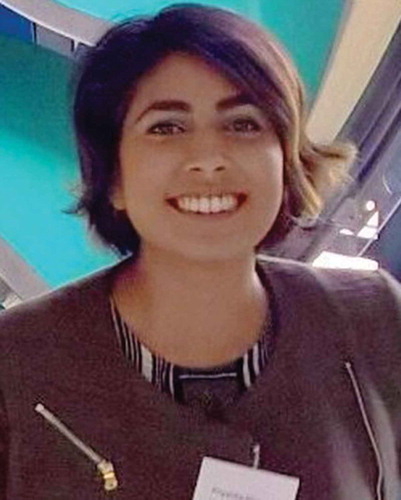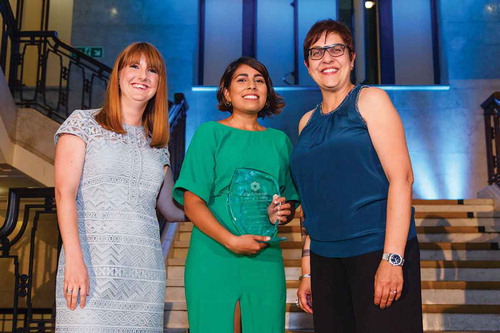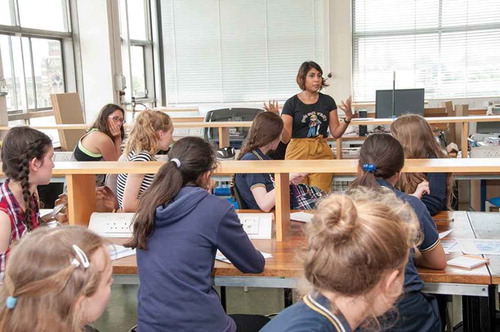1. What made you decide to be an engineer?
I was always interested in and good at Maths and Science, so was inclined towards a scientific discipline from a young age. My father is a Mechanical Engineer, so I was exposed to the field from early on. Although my father specialises in pneumatic systems, which didn’t excite me in the least, and I thought that’s what all engineers do. In primary school, we learned about Roberta Bondar, the first Canadian woman in space and that’s where I became interested in aerospace engineering. Initially, I wanted to be an astronaut, but I thought aerospace engineering was a good backup plan in case the former didn’t work out! The support and encouragement from my parents and teachers was crucial towards making this decision.
2. Could you tell us about what do you as a Senior Research Associate at the Oxford Thermofluids Institute?
My research expertise is in the field of applied computational fluid dynamics (CFD) of jet engine heat transfer, aerodynamics and aeroelasticity. I currently lead the CFD modelling campaign for various projects, in collaboration with industry partners and research groups, relating to various cooling system problems in modern jet engines. I also teach undergraduate students in relevant topics like thermodynamics, fluid mechanics, heat transfer and mathematics.
3. What do you enjoy most about researching applied CFD, or working in engineering more broadly?
I enjoy the fact that I get to solve real problems, that often seem so complicated, but once broken down into smaller problems, can be solved more easily. CFD, alongside experimental data, plays a huge role towards demystifying the underlying flow physics of jet engines. I also love that my research can have a tangible impact on the environmental goals of the aviation industry, like reducing CO2 emissions, and having these new technologies being implemented by our industry partners on their next generation of engines.
4. Who or what inspires you?
Many people inspire me—they don’t necessarily have to be engineers. I admire people who swim against the tide to pursue their dreams. This often includes women in male-dominated fields who have to fight against outdated perceptions of their gender to make progress. I love it even more when they help other women behind and alongside them.
5. Last year you were named as one of the Top 50 Women in Engineering under 35, as awarded by the Women’s Engineering Society. Congratulations! What did it mean to you to be included in such a high achieving group of female engineers?
Thanks! It meant a lot to me to be recognised for my research and efforts to improve the gender imbalance in my field. Often, the reward for good work is just more work! So, it is nice to have a hugely influential institution like the UK Women’s Engineering Society say, “You’re doing great, and we hope you continue doing this”.
6. As one of the top young women in engineering, do you consider yourself to be a role model for the next generation of engineers?
I honestly don’t, but I have realised that all women who are minorities in their immediate surroundings become role models, whether they realise it or not, by just being there. This can be a big responsibility, especially when all they are trying to do is their job and make progress with their own goals. But, I believe there is a degree of altruism within most people (myself included), along with a need to create a fairer and more just society for future generations. I think it makes us human. So, I do understand the responsibility and do my best to fulfil it.
7. You are also Co-ordinator of Women in Engineering Oxford, a women’s networking group set up by the University of Oxford. What motivated your interest in this initiative? And what do you hope to achieve through your involvement?
When I first moved to Oxford to begin my job as a postdoctoral researcher, I didn’t know anyone besides my partner. At the time, there was a keen group of female postgraduate students in my research group who had just helped set up this network. They encouraged me to join, and I did so as a way of meeting more like-minded women. It had a huge effect on me, and made me realise the need for these kinds of networks.
Being part of the network helped me so much that when the co-founding group of women graduated and left, I took over the coordination and management of the group. My hope is that it will help other women like it helped me—by providing a supportive environment where we can address issues of gender imbalance, inspire and motivate each other to continue with our individual paths, however diverse they may be. The network is also a platform for us to raise issues with the Department directly, who continue to listen and support us.
Figure 4. Next to the Rolls-Royce Olympus engine that powered the Concorde aircraft. Source: University of Oxford
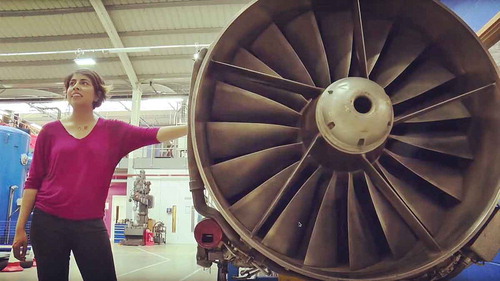
We run several seminars to highlight female role models in engineering at various career stages, networking and social events, and more recently, outreach events for high school female students.
8. When working or researching in engineering, have you noticed a gender imbalance? How has it affected you?
I have been a minority within heavily male-dominated environments throughout my engineering career and I’ve felt the effects of the resulting imposter syndrome.
(“Impostor syndrome is a psychological pattern in which people doubt their accomplishments and have a persistent, often internalised fear of being exposed as a ‘fraud’”) Source: Clance, Pauline Rose; Imes, Suzanne Ament (Fall 1978).” The imposter phenomenon in high achieving women: dynamics and therapeutic intervention”. Psychotherapy: Theory, Research & Practice. 15 (3): 241–247
Combined with the fact that I have always struggled with confidence, imposter syndrome has held me back on many occasions from speaking up, trying new things and feeling like I deserve to be here.
Figure 5. At an outreach event held on National Women in Engineering Day at St John's College, Oxford. Source: University of Oxford
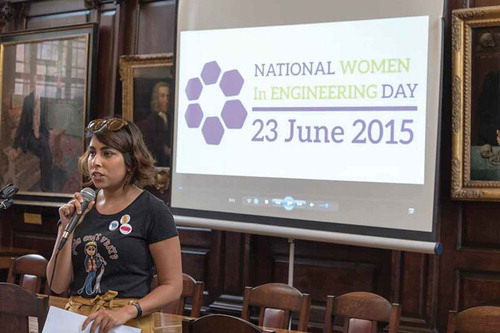
I also struggle with explaining this to male colleagues who occasionally feel imposter syndrome too, but not to the same extent.
9. As a woman in engineering, have you ever had to overcome any gender barriers? What do you think is the reason for these barriers existing?
I have been fortunate enough to have never experienced any overt barriers due to my gender, but I do know they exist. The types of barriers I have faced have been subtler, like my idea of not being taken seriously in a meeting until a male colleague repeats it. You can see how that would be difficult to challenge without seeming like a victim, how that could make one more reluctant to speak up and how that reinforces imposter syndrome.
Other subtle barriers include not being assumed to be knowledgeable on engineering topics in networking situations, being talked over, have comments made on my appearance rather than my ideas, etc. It can be exhausting to challenge every single one, and defeating to just ignore them. I often pick my battles based on how important the situation is, and how much energy I have.
These subtle barriers exist because of people’s outdated perceptions of gender (often backed by dubious science, like quoted in the Google employee’s controversial memo). They also exist because of people’s outdated perceptions of what an engineer looks like, sounds like and what an engineer does. I think men and women internalise these stereotypes equally.
10. Why do you think engineering is often perceived as a “male” occupation or area of interest?
I think it has been a self-perpetuating cycle. Outdated gender stereotypes of what men and women are better suited to has meant boys and girls are encouraged/discouraged in different ways. Historically, the discouragement of girls has been direct—they were literally excluded from a university education and many professions like engineering. In modern society, the discouragement doesn’t need to be overly direct to have an influence, and could be as subtle as the number of dolls vs. the number of LEGO sets gifted to a young girl, or an absence of female role models in engineering.
This in turn creates a generation of male-dominated engineering cohorts, with women who remain as minorities. The subtle and overt barriers at every career stage result in very few women reaching senior levels, which further perpetuates the outdated gender stereotypes, and so it keeps going.
11. The conversation around women in STEM subjects, engineering in particular, has been ongoing for some time. What more, in addition to existing initiatives, needs to be done in order to address the balance of women and men in engineering?
The conversation often frames young girls as the ones who need to be changed, who we need to “get interested in STEM subjects”. I have found that girls are very much interested in STEM subjects and tend to be intelligent enough. But they encounter the same subtle gender stereotypes in every environment they’re exposed to—home, classroom and media, along with inadequate careers advice from schools.
I agree that we need to continue to reach girls from a young age with engaging STEM outreach activities, but we also need to get parents, educators, toy companies and children’s entertainment providers on-board to challenge the stereotypes they convey. We need to disrupt that self-perpetuating cycle.
12. How can information about how to get into engineering be made more available and accessible to young women?
Through “This is Engineering” (www.raeng.org.uk/education/this-is-engineering), I think The Royal Academy of Engineering (RAEng) along with other institutions are doing exactly the right thing by using social media platforms and various other online platforms to disseminate short, exciting videos on engineering. These videos include female engineers and information on engineering in a clear, engaging format.
There is also a great public engagement initiative called Soapbox Science (http://soapboxscience.org), where female scientists stand in a public place and talk about their research to passers-by. Perhaps we can create a similar format specific to engineering.
I also think all-female workshops at primary/high school level would make a big difference. They could be classes where we could learn to fix our bikes and other everyday items. The confidence from working with one’s hands on fixing a mechanical item could do wonders for girls believing that engineering is a viable option. In fact, I want to sign up to one myself!
13. Do you have any advice for young women starting out in engineering?
You don’t have to be a genius. Just work hard and be honest about your strengths and limitations.
Engineering is hugely important to our society. It is also exciting and rewarding—you are helping make the world a better place.
Find and hold on to a support network, like friends, family, Women in Engineering or other minority networks.
Be kind to yourself.
You are not alone.

